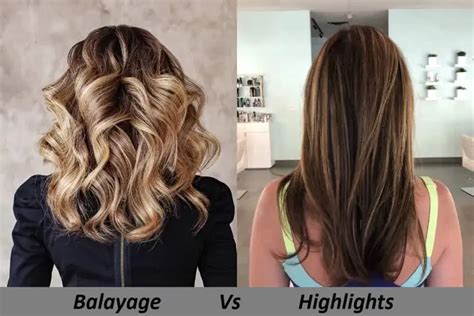Highlights vs. Balayage: Understanding the Distinctions
Highlights and balayage are two popular hair coloring techniques that can enhance your look and add dimension to your hair. However, there are some key differences between the two techniques that you should be aware of before making your decision.

1. Definition:
Highlights: Highlights involve adding small, fine streaks of color to your hair, creating a more subtle and natural-looking effect.
Balayage: Balayage is a freehand technique where the color is painted onto the hair in soft, sweeping strokes, resulting in a sun-kissed, lived-in look.
2. Application:
Highlights: Highlights are typically applied using foil or a cap, which allows the color to be applied to specific sections of hair.
Balayage: Balayage is applied freehand, without the use of foil or a cap. This allows the colorist to create a more blended and natural-looking effect.
3. Maintenance:
Highlights: Highlights require more frequent touch-ups, typically every 6-8 weeks, as the new growth becomes more noticeable.
Balayage: Balayage is less maintenance-intensive, as the color is blended into your natural hair color, making the regrowth less apparent.
4. Versatility:
Highlights: Highlights can be customized to create a variety of looks, from subtle to bold. They can be placed in specific areas to frame the face or add depth to the hair.
Balayage: Balayage is best suited for creating a sun-kissed, lived-in look. It is not as versatile as highlights in terms of placement and customization.
5. Cost:
Highlights: Highlights are generally more expensive than balayage due to the time and effort required to apply the foils or cap.
Balayage: Balayage is typically more affordable than highlights, as it is less labor-intensive and does not require the use of foils or a cap.
Choosing the Right Technique for You
The best hair coloring technique for you will depend on your individual hair type, style, and preferences. Here are some key considerations to keep in mind:
-
Hair type: Highlights are suitable for most hair types, but they may be more noticeable on thicker hair. Balayage is a better option for fine hair, as it creates a more subtle and blended effect.
-
Style: Highlights can be used to create a variety of looks, from classic to edgy. Balayage is best suited for a sun-kissed, lived-in look.
-
Preferences: Consider your own preferences for maintenance and versatility. If you prefer a subtle and low-maintenance look, balayage may be a better option. If you want more customization and bolder results, highlights may be a better choice.
Highlights vs. Balayage: Pros and Cons
Highlights:
Pros:
- Versatile: Can be customized to create a variety of looks.
- Dramatic: Can create a bold and eye-catching effect.
- Long-lasting: With proper care, highlights can last for several months.
Cons:
- High maintenance: Requires frequent touch-ups to maintain the desired look.
- Damage: Foils can cause some damage to the hair.
- Costly: Can be more expensive than other hair coloring techniques.
Balayage:
Pros:
- Low maintenance: Requires less frequent touch-ups than highlights.
- Natural: Creates a sun-kissed, lived-in look that blends into your natural hair color.
- Affordable: Typically less expensive than highlights.
Cons:
- Less versatile: Best suited for creating a sun-kissed, lived-in look.
- Subtle: May not create as dramatic a result as highlights.
- Can be messy: Freehand painting can sometimes result in splattering or uneven application.
The Future of Hair Coloring: Creative Applications
The future of hair coloring is bright, with new techniques and applications emerging all the time. One exciting trend is the use of creative new words to generate ideas for new applications. For example, the word “glossiage” has been coined to describe a technique that combines highlights and balayage to create a super-shiny, multidimensional look.
Other innovative applications include:
- Ombré balayage: A gradual transition from dark roots to light ends, created using a combination of balayage and ombré techniques.
- Reverse balayage: A technique where the color is applied to the roots, creating a darker base with lighter highlights towards the ends.
- Rainbow balayage: A colorful and vibrant take on balayage, where multiple colors are blended to create a rainbow effect.
Conclusion
Highlights and balayage are both versatile and stunning hair coloring techniques that can add dimension and interest to your look. Understanding the key differences between the two techniques will help you make an informed decision about which one is right for you. Whether you prefer a subtle and natural-looking effect or a bolder and more dramatic statement, there is a hair coloring technique that will suit your needs and preferences.
